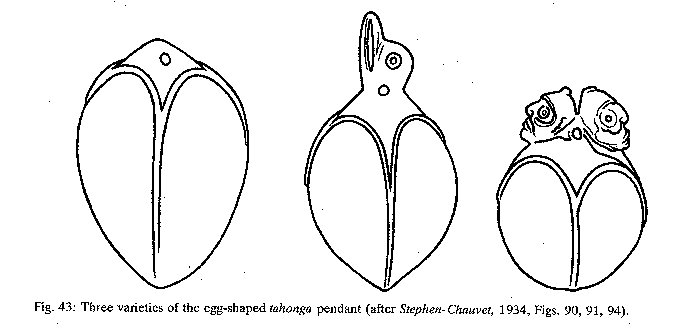| TAHONGA "Although stone specimens do occur, most tahonga are carved from toromiro, like the wood carvings described above. Great numbers have been collected, some of considerable antiquity, although commercial production was started in the late eighties of last century. Basically, the form is that of a somewhat egg-shaped ball with a central projection at its thickest end perforated for a suspension string. The resemblance to an egg is reduced by the fact that the tahonga is divided longitudinally into four equal sections by four narrow ribbons or ridges radiating symmetrically from the most pointed end of the ball. At the rounded transition to the thicker end each ribbon forks into two branches as wide as the original ones, and these curve in both directions to run uninterruptedly into the meeting branches from the two neighboring ribbons. Seen from the rounder end of the ball, these interlocked branches outline a star-shaped square with concave sides and corners drawn out into points. Placed centrally in this modified square is the small rounded or cylindrical projection perforated for the suspension string. In some specimens this projection is shaped into either a single or a double human head, and sometimes also into the head of a bird with a large upturned bead. Obsidian disks with bone rings are inlaid as eyes in these heads. The surfaces are polished and left unpainted. Tahonga balls are commonly about 3-4 ins. (8-10 cm.) along the axis, although they may vary somewhat in size.
Possible origins: The tahonga was supposed to be a feminine ornament, although Métraux's (Ibid., p. 233) modern informants believed this was not universally so. Specimens with a bird's head projecting from the top (Fig. 43 center) suggest a cracking egg about to fall into four equal parts as the chicken emerges. Some tahonga have a rather striking resemblance to a coconut covered with its outer husk, although a husked coconut has a rounded triangular cross section. The theory that the pendant is an imitation of coconuts which grew in the homeland of the ancestors has been both defended and rejected (loc. cit.). In either case we would have had no guide as to the origin of this purely local ornament, since coconuts grew in a restricted grove on Easter Island itself prior to missionary arrival (Heyerdahl, 1961, p. 30). As concluded by Métraux (1940, p.236), the wooden tahonga seem to be paraphernalia entirely peculiar to Easter Island. Since some tahonga have a twin human head emerging from the top (Fig. 43 right) it is interesting to recall the belief prevailing in some parts of the Inca Empire, that the first Inca and his sister-wife originally emerged from an egg. The association seems pertinent when we note that Hotu Matua, the traditional founder of the Easter Island dynasty, who was recalled to have come from the direction of Peru, was remembered as the son of a king named Tupa-ringa-anga (Métraux, 1940, p. 127). Anga means to 'create' on Easter Island, and Tupa-ringa strongly suggests Tupa-inga, a name frequently given to Inca Tupac, the late Inca who sailed with a fleet into the Pacific to visit islands known to his coastal merchantrs. This late Tupa-inga had only taken his name from several of his own predecessors, since there were no less than 20 kings with this name in the Peruvian genealogical lines, most of them going back into pre-Inca dynasties (Monesinos, 1642)." (Heyerdahl 3) |
